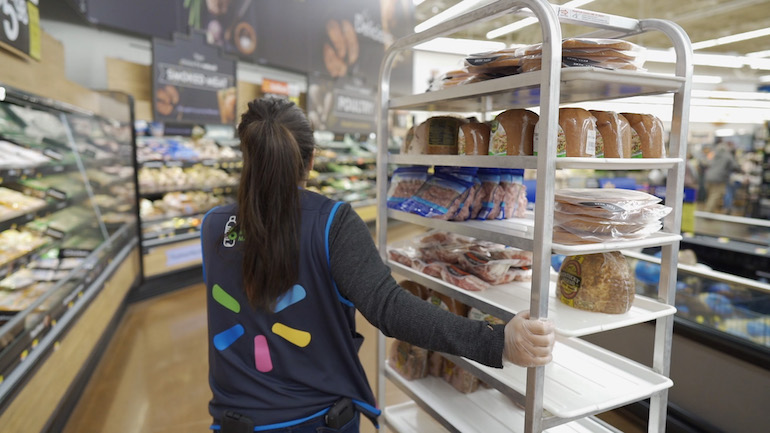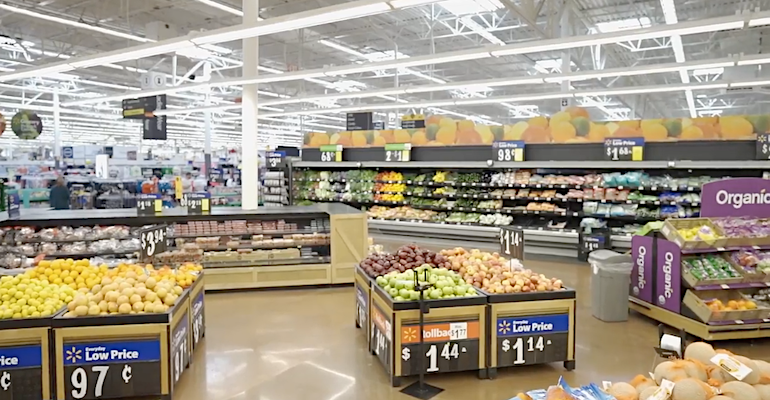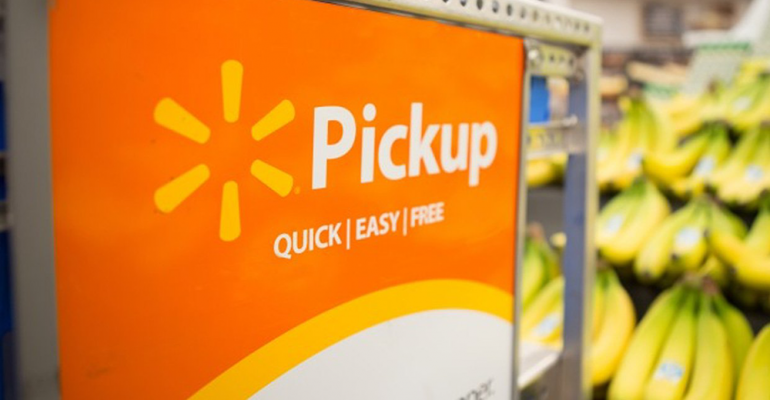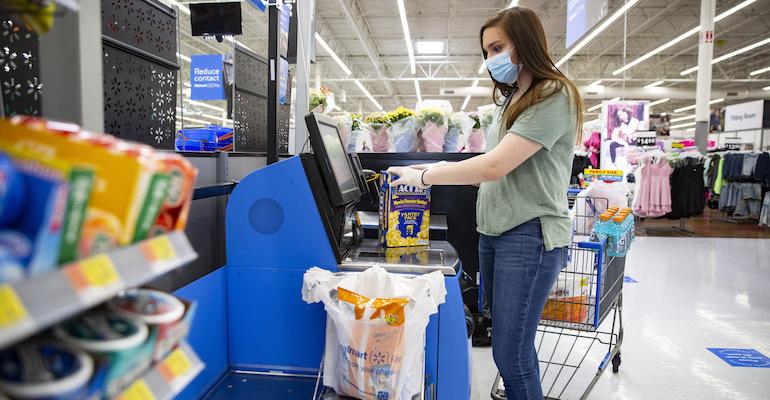Atop elevated results a year ago, Walmart recorded robust comparable-sales gains for its U.S. businesses in the fiscal 2022 third quarter, with over 9% growth at Walmart U.S. and a double-digit increase at Sam’s Club.
For the quarter ended Oct. 31, Walmart totaled revenue of $140.52 billion, up 4.3% from $134.71 billion a year earlier. Excluding the impact of foreign exchange, revenue rose 3.3% to $139.2 billion, the Bentonville, Ark.-based retail giant said Tuesday. The gain built on 5.2% revenue growth (6.1% in constant currency) in the fiscal 2021 quarter.
“All segments saw strong top-line gains in the quarter, excluding divestitures,” President and CEO Doug McMillon told analysts in a conference call on Tuesday morning. “Walmart U.S. drove a sequential acceleration in comp sales both on a one- and two-year basis and continued to gain market share in grocery. Sam’s Club had another very strong quarter, as did Walmart International, with China, Mexico and India leading the way. Customers and members are shopping with us across channels, and we’re making it easier for them. Speed matters. That’s why we offer fast same-day delivery to millions of customers around the world.”
At Walmart U.S., third-quarter net sales climbed 9.3% to $96.61 billion from $88.35 billion a year ago. Comparable sales grew 9.6% year over year (9.2% excluding fuel), with the average ticket size up 3.3% and the number of transactions rising 5.7%. On a two-year basis, comp sales were up 15.9% (15.6% excluding fuel), reflecting the prior-year gain of 6.3% (6.4% excluding fuel). Basket size increased 27% over two years.
Within grocery, food sales grew by $3.6 billion, the strongest quarterly growth in six quarters, Walmart said.
E-commerce sales at Walmart U.S. rose 8% in the third quarter and contributed about 10 basis points to comp-sales growth, Walmart reported. Including the fiscal 2021 quarter’s 79% gain, online sales were up 87% on a two-year stack.
Walmart noted that its U.S. e-commerce marketplace expanded its assortment by 21 million items in the third quarter. On the fulfillment side, Walmart U.S. now has about 4,300 pickup sites and same-day delivery from more than 3,300 stores. The company added that its proprietary Spark driver platform for deliveries has continued to grow and is now active in 900 cities, providing access to over 50% of U.S. households.
Among product categories, grocery turned in comp-sales growth of nearly 10% in the third quarter, reflecting low- to mid-single-digit ticket inflation plus strong market share gains, as reported by Nielsen, according to Walmart. Two-year comp growth for grocery was up by a mid-teens percentage.
“We’re pleased with the strong momentum in the grocery business, as our strong price positioning and omni offerings resonate with customers,” Walmart Chief Financial Officer Brett Biggs said in the call.
Food sales growth was strong across segments, particularly in fresh foods, according to Walmart.
Within grocery, food sales grew by $3.6 billion, the strongest quarterly growth in six quarters, Walmart said. The company noted that food sales growth was strong across segments, namely in fresh foods. Pet, baby and beauty care were among the top-performing categories in consumables.
The health and wellness category saw mid-teens comp-sales growth in the quarter, reflecting increased prescriptions — including COVID-19 vaccinations — and branded drug inflation, Walmart reported.
“Walmart U.S. comp sales of 9.2%, or 15.6% on a two-year stack, is remarkable growth. The gains we’ve seen in market share for grocery and strong back-to-school results indicate our inventory position has improved,” McMillon said. “Prices and assortment are compelling, and customers continue to move away from early pandemic behaviors. We see tailwinds in our results. A strong consumer, a degree of inflation and government stimulus are all factors, but I also like what I see in the core of the business. Transaction counts in our stores and clubs are growing. Inventory is up 11.5%. Our price gaps are where we want them.”
Sam’s Club tallied net sales of $18.97 billion in the third quarter, up 19.7% from $15.85 billion in the prior-year period, when sales rose 6.3%. Membership income increased 11.3%, the fifth straight quarter of double-digit growth, according to Walmart.
Comp sales at Sam’s rose 19.8% overall and were up 13.9% excluding fuel, compared with growth of 7.9% (11.1% excluding fuel) a year ago. On a two-year stack, the warehouse club chain’s comp sales advanced 25% through the quarter’s end, Walmart said. Transactions climbed 11.1% and the average basket grew 2.6%. E-commerce sales increased 32% — atop 41% growth a year earlier — and contributed 170 basis points to comp sales growth.
Sam’s posted high-teens comp-sales gains in grocery/beverage and consumers, with mid-teens growth for the fresh/freezer/cooler category, led by fresh meat and produce, prepared foods and floral. Health and wellness comps rose by low single digits.
“Both individual and business members are shopping with us across channels and using the digital tools we’ve developed,” McMillon noted. “The new Don’t Forget function with Scan & Go is a great example. It’s a completely digital way for us to help members and drive basket size at the same time. Based on a member’s shopping history, we can target items that a member may be forgetting in their trip all through the app, and we already see an increase in the number of items in the basket. We’re also expanding delivery options at Sam’s. We now offer same-day delivery for 440 clubs using our Spark Driver network.”
Overall U.S. comparable sales, including Walmart U.S. and Sam’s Club, advanced 11.1% in third quarter (9.9% excluding) versus 6.6% (7.1% without fuel) in the fiscal 2021 quarter.
Walmart International saw third-quarter net sales drop 20.1% to $23.63 billion from $29.55 billion a year earlier, reflecting a negative impact of $9.4 billion related to divestitures, Walmart said. In constant currency, international net sales fell 24.6% to $22.3 billion. Flipkart (India), China and Mexico delivered strong e-commerce, the company noted.
“In the third quarter, momentum continued with strong sales and profit growth in each of our segments, while continuing to accelerate our strategic priorities,” Biggs said. “We’re off to a good start for the holiday season and in good position to continue delivering strong results.”
Walmart U.S. now has about 4,300 pickup sites and same-day delivery from more than 3,300 stores.
Biggs pointed out that Walmart is weathering the unstable economic climate well, including labor and supply chain issues as well as inflation.
“Despite the various macro and industry challenges, our inventory position is good. Stores and fulfillment centers are well-staffed, and our price position remains strong,” he said. “Customers should expect to find the items they want at great values, and we are ready to serve them however they want to shop. Our omni model is a substantial competitive advantage as shopping behaviors continue to evolve. Customers want choices in how they shop, and our unique set of assets with a network of stores, expanding digital capabilities, robust distribution networks and innovative services very effectively serve their evolving needs.”
At the bottom line, Walmart reported fiscal 2021 third-quarter consolidated net income (attributable to the company) of $3.11 billion, or $1.11 per diluted share, compared with $5.14 billion, or $1.80 per diluted share, a year ago. Excluding a loss from debt extinguishment (67 cents per diluted share) and unrealized equity investment gains (33 cents per diluted share), adjusted net earnings per share were $1.45, just over the midrange of Wall Street’s projection.
Analysts, on average had forecast adjusted EPS of $1.40, with estimates ranging from a low of $1.33 to a high of $1.53, according to Refinitiv.
“We anticipate Q4 Walmart U.S. comp sales excluding fuel increasing around 5%, resulting in over 6% gain for the full year. Annual adjusted EPS is expected to be around $6.40 for the year, representing 17% growth,” Biggs said. “We continue to make good progress on our capital investments, but we now anticipate the timing of some investments originally planned for this year will flow into next year. As a result, we expect full-year capex to be around $13 billion versus our original guidance of $14 billion.”
Wall Street’s consensus estimate is for fiscal 2022 adjusted EPS of $6.33, with projections running from $5.92 to $6.63, according to Refinitiv.
Walmart closed out the third quarter with 10,524 stores worldwide, including 4,740 Walmart and 599 Sam’s Club stores in the United States and 5,185 international locations.





